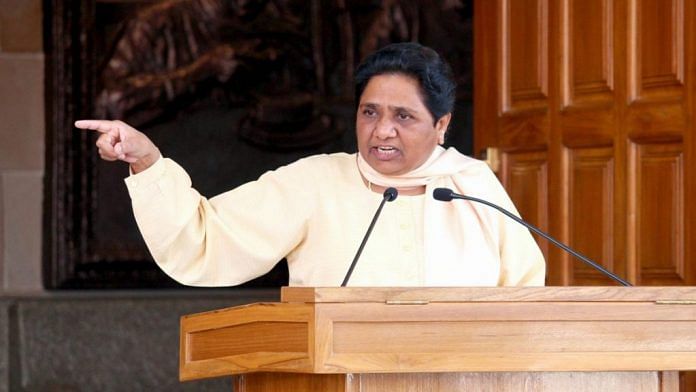The electoral performance of the Bahujan Samaj Party (BSP) has been continuously declining since 2007. The party has been witnessing a three dimensional decline— geographical, sociological and political. Geographically, it has been losing its support outside of Uttar Pradesh, and even in some parts of the state such as Bundelkhand; the sociological decline means it has been losing support of its traditional social base. By political decline, I suggest the party’s inability to promote charismatic leaders or induct heavyweights from other organisations. Hence, this decline has not only led to a reduction in the number of seats but also its vote share in both general as well as assembly elections. Some political experts have been under the impression that the party might bounce back, but the mass exodus of its senior leaders after the 2019 general election diminishes all such hopes.
But why has the party been declining? Based on three rounds of my fieldwork and interaction with the office-bearers and supporters of the BSP, I find three prime explanations.
Leadership transition
The BSP has gone through a leadership transition in the last decade, but unlike other political parties, it has not been a smooth one. The transition could never get settled and led to the exodus of its senior leaders. In fact, the exodus began way back in 1986 when Kanshiram, for the first time, tried to project Mayawati as a future leader by increasing her rank within the party. Kanshiram’s colleagues from the All India Backward and Minority Communities Employees Federation (BAMCEF) left him protesting his decision.
Around 1995, the party saw a second wave of exodus when powerful leaders such as Sone Lal Patel, Ram Lakhan Verma, among others with socialist backgrounds, left the organisation. This was the period when Mayawati established herself in the politics of Uttar Pradesh. The party witnessed the third wave of exits after the demise of Kanshiram when Mayawati formally took control of the organisation. In order to take control of the financial resources of the party, the not-so-loyal leaders were expelled.
After the breaking of the alliance with the Samajwadi Party, the latest round of exodus has begun. This time, the leaders of Mayawati’s own caste have been deserting the party. It is also marked by Mayawati’s attempt to hand over the mantle to her nephew. During the time of Kanshiram, when the party saw the exodus of leaders, it was able to compensate by promoting new faces. Hence, such exits could not harm him significantly. However, Mayawati failed to replicate this strategy. This has led to diminishing support for the party in the respective caste and communities (Maurya, Kushwaha, Nishad, Pasi, among others), leaders of which have left the party.
Also read: Four factors Yogi Adityanath had in mind before picking his seven new cabinet ministers
Form cadre-based party to a patronage-based organisation
‘The Cadre camp of our party has been stopped, so our party does not have well-trained people who can communicate the message of the leadership correctly among the masses’ — this has been a common answer of the party office-bearers and supporters when asked about the reasons for the decline of the BSP, electorally. Previously, the party used to train its office bearers occupying positions till the bottom rank. So, when an MP or an MLA used to exit, it did not damage the party’s prospects to a great extent, thanks to a well-oiled organisational structure.
However, this arrangement started creating troubles after 2007 with the party having a sizable number of upper caste elected representatives who were often in disagreement with the local leadership. To avoid this, Mayawati directed that the appointments of all district and Vidhan Sabha presidents be done in concurrence with party MPs and MLAs. This decision has been fatal because MPs and MLAs started appointing their own clients as party office bearers. And when those leaders switched sides, the entire local party machinery followed. The ultimate outcome of this is that today the organisational structure of the party has a very weak presence at the grassroots.
Also read: Why Ambedkar changed on separate electorate. His shift was strategic not voluntary
Failure of ‘coalition of extremes’ strategy
American Political Scientist Paul R. Brass, in the 1980s, coined the term “coalition of extremes” to explain the social base of the Congress party. He argued that the Congress in Uttar Pradesh has been surviving based on a “coalition of extremes”. Three social classes, namely Dalits, Muslims, and Brahmins formed this coalition. It was a coalition of extremes because Dalits and Brahmins were poles apart vertically, so were Muslims and Brahmins horizontally. Ever since her victory in the 2007 assembly election, Mayawati has been consistently trying to embrace this social coalition, but has failed because of the rise of the BJP. The BJP’s rise has altered the voting behaviour of the Muslims who are now more likely to choose a candidate who has the potential to defeat the BJP rather than candidate of their own religion. However, Mayawati is still looking to mobilise Muslim voters by nominating a large number of Muslim leaders.
Arvind Kumar is PhD Scholar of politics at the Department of Politics & International Relations, Royal Holloway, University of London, UK. Views are personal.
(Edited by Humra Laeeq)



